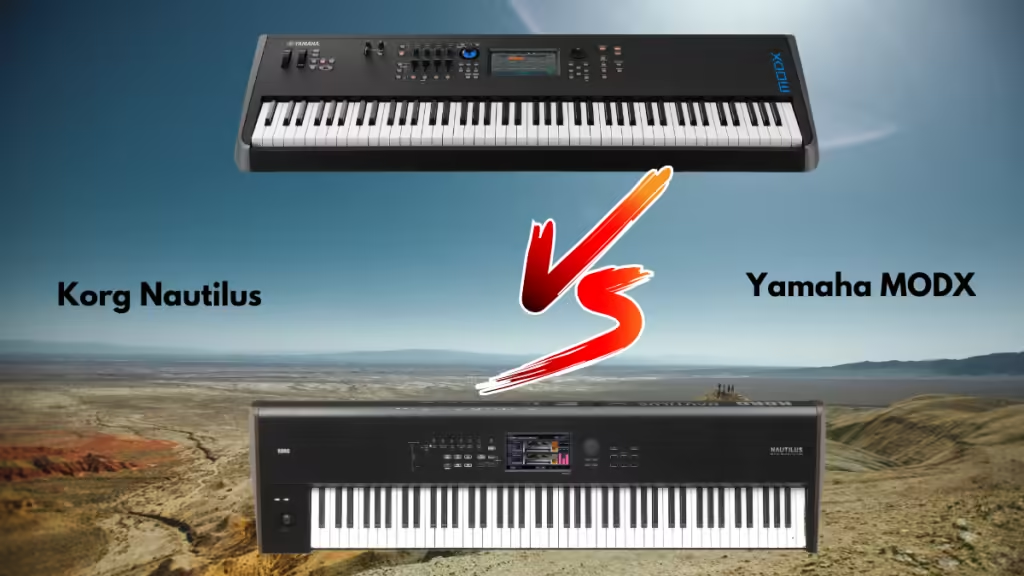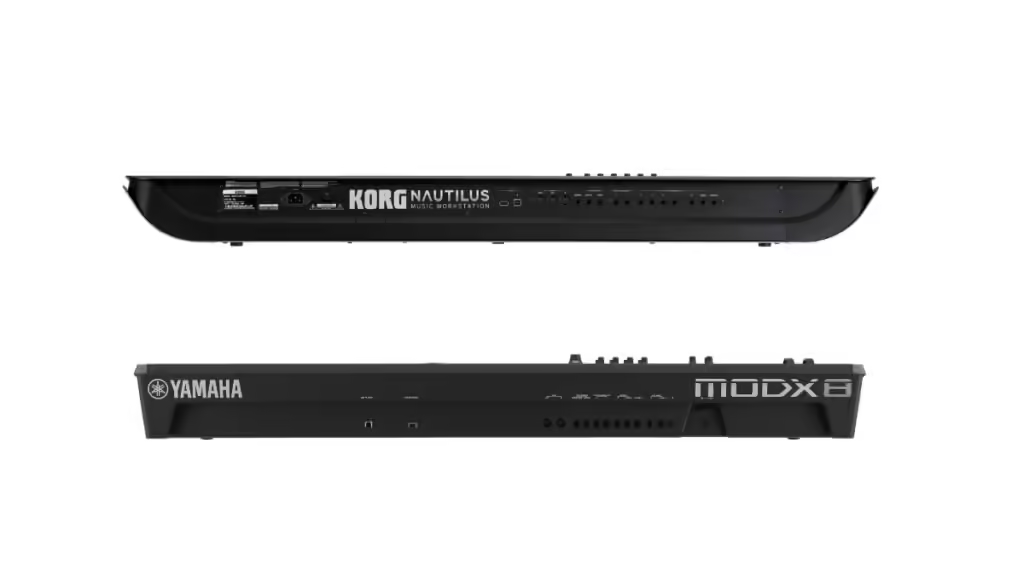Korg Nautilus vs. Yamaha MODX 2024: Ultimate Synthesizer Showdown

Korg Nautilus vs. Yamaha MODX
The Korg Nautilus and Yamaha MODX are two powerhouse synthesizers that offer excellent features for modern music production. As multi-functional workstations, they each bring unique strengths to the table, from sound engines and effects to ease of use. This comparison review will explore these synthesizers across key specs, focusing on their suitability for diverse production needs.
1. Build Quality and Design
- Korg Nautilus: The Nautilus has a modern and sleek design, offering a sturdy build suitable for both studio and live use. It includes an intuitive touchscreen interface that simplifies navigation, with dedicated buttons for frequently used features. The layout is clean, allowing quick access to the synth’s nine sound engines and extensive effects.
- Yamaha MODX: The MODX has a lightweight but robust build, especially designed with portability in mind. Its interface includes a large color touchscreen with intuitive control knobs and faders that provide easy access to sounds and parameters. It is slightly more compact than the Nautilus, which makes it a great choice for gigs and mobile setups.
Verdict: Korg Nautilus offers a more substantial build quality suited for both studio and live use, while the MODX is lighter and more portable, making it an ideal choice for on-the-go musicians.
2. Sound Engines and Synthesis Capabilities
- Korg Nautilus: Equipped with nine different sound engines, the Nautilus can recreate a vast array of tones, from analog synths to pianos and sample-based sounds. The engines include Wave Sequencing, FM synthesis, and physical modeling, allowing deep sound design and unique textures. It’s particularly known for its exceptional pianos and realistic acoustic instruments.
- Yamaha MODX: The MODX features Yamaha’s AWM2 (Advanced Wave Memory) engine along with the powerful FM-X (Frequency Modulation) engine, combining sample-based synthesis and FM synthesis. This combination offers rich, expressive sounds, with a strong emphasis on intricate digital textures and evolving pads. Its FM synthesis allows for deep sound manipulation, making it a popular choice for electronic and ambient music.
Verdict: Both synthesizers excel in their own domains. Korg Nautilus offers a broader range of synthesis engines, making it more versatile for recreating acoustic and synthetic textures, while Yamaha MODX excels in FM synthesis and evolving digital textures, ideal for experimental and electronic music.
3. Effects and Sound Processing
- Korg Nautilus: The Nautilus includes a comprehensive suite of effects with 197 options, including reverbs, delays, modulation effects, and guitar amp models. It allows users to apply up to 16 effects simultaneously, giving plenty of room for intricate sound processing. Additionally, its onboard compressor and EQs help shape the mix for professional sound quality.
- Yamaha MODX: MODX offers a strong selection of effects, including VCM (Virtual Circuit Modeling) effects, which emulate vintage analog effects. Its Reverb and Motion Sequence functions create immersive soundscapes that react dynamically to performance changes, adding a unique level of expressiveness to the sounds.
Verdict: Korg Nautilus leads in flexibility with the sheer number of available effects, while the MODX shines in creating dynamic, reactive soundscapes ideal for ambient and electronic music.
4. User Interface and Workflow
- Korg Nautilus: With a 7-inch color touchscreen, the Nautilus makes browsing and editing sounds easy. Its interface is well-suited for in-depth sound design and includes several performance options like Set List mode, which allows for easy sound switching during live performances.
- Yamaha MODX: MODX also offers a color touchscreen along with various knobs and sliders, which provide hands-on control for quick sound adjustments. Its Super Knob feature allows for real-time morphing between sounds, a powerful tool for live performance. The MODX interface emphasizes user-friendly access to presets and sound adjustments, making it a bit quicker to operate than the Nautilus.
Verdict: Yamaha MODX offers a more streamlined interface with a focus on live control, while the Korg Nautilus provides a more in-depth editing environment, making it better for intricate studio production.
5. Polyphony and Voice Count
- Korg Nautilus: Offers up to 60-120 voice polyphony depending on the engine used, which is more than adequate for most applications but can vary depending on the complexity of the patch.
- Yamaha MODX: Provides a high polyphony count, with 128-note polyphony on AWM2 and 64 notes on FM-X. This allows for complex layering and dense compositions without note dropouts, especially important for highly detailed and layered performances.
Verdict: Yamaha MODX has a higher total polyphony, which is an advantage for performance-heavy compositions and complex, layered sounds. Korg Nautilus is more variable in its polyphony, which might require some adjustment based on the sound engine in use.
6. Connectivity and Expandability

- Korg Nautilus: The Nautilus offers balanced outputs, USB-MIDI, and audio interfaces, along with MIDI in/out/thru ports. It also supports USB flash drives for loading and saving samples and sounds. Additionally, it has an SD card slot for memory expansion.
- Yamaha MODX: MODX includes USB audio and MIDI connectivity, allowing for direct integration with DAWs. It also features MIDI in/out, stereo outputs, and an auxiliary input for integrating external audio. MODX, however, lacks the SD card slot for expandability, relying more on its USB for data storage.
Verdict: Korg Nautilus offers more expandability options with its SD slot, whereas Yamaha MODX is highly integrative with DAWs but lacks additional memory storage options.
7. Sound Quality and Performance Applications
- Korg Nautilus: The Nautilus is recognized for its high-fidelity sound, especially for acoustic instruments and lush textures. Its sound quality and flexibility make it well-suited for diverse genres, including orchestral and cinematic music.
- Yamaha MODX: Known for powerful, rich, and textured FM sounds, the MODX excels in electronic, ambient, and pop genres. The Super Knob and Motion Control make it highly expressive for live performances, offering real-time control over complex sound transitions.
Verdict: Korg Nautilus is excellent for acoustic, cinematic, and orchestral sounds, while Yamaha MODX is ideal for electronic and ambient genres, providing deep expressiveness for live and studio work.
Pros and Cons
Korg Nautilus
- Pros:
- Nine diverse sound engines.
- High-quality acoustic instrument sounds.
- Extensive effects selection (197 effects).
- Intuitive touchscreen interface.
- Expandable via SD slot.
- Cons:
- Variable polyphony depending on sound engine.
- Interface may take longer to navigate in live settings.
Yamaha MODX
- Pros:
- High polyphony (up to 128 AWM2 and 64 FM-X).
- Super Knob for real-time sound morphing.
- Lightweight and portable.
- Great for electronic and ambient music.
- Strong integration with DAWs.
- Cons:
- Lacks SD slot for expandability.
- Effects are fewer than Nautilus, focused on vintage emulation.
Conclusion
The Korg Nautilus and Yamaha MODX each cater to different aspects of music production:
- Korg Nautilus is a versatile synthesizer with multiple sound engines and a large effect selection, making it ideal for producers who need a wide range of acoustic and electronic sounds for both studio and live use.
- Yamaha MODX focuses on high polyphony, live expressiveness, and digital textures, making it a go-to for electronic musicians and live performers who need portability and dynamic control.
Ultimately, your choice will depend on your production style and setup needs. For sound versatility and production flexibility, Korg Nautilus is the preferred choice. For live performance, dynamic sound manipulation, and a lightweight design, the Yamaha MODX is an excellent investment.
